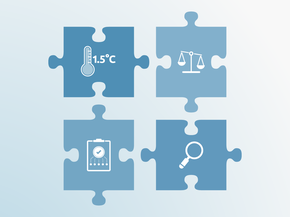Mitigation options
Overview
Although the main measures to reduce GHG emissions that have been implemented so far focus on the energy efficiency of ships, a series of measures could be implemented by ships container companies and incentivised by national policies in order to reduce their emissions to reach carbon neutrality by 2050 at the latest (OECD, 2018).
While the switch to alternative fuels - along with operational and technical measures - constitute major mitigation options to decarbonise shipping, there is significant emissions reduction potential for the sector in the trade of fossil fuel commodities. This could be driven by government commitments to decarbonising their economy and reducing their use of coal and oil. In 2018, fossil fuel commodities trade represented between 29%-31% of total trade (OECD, 2018; UNCTAD, 2019).
Demand and global consumption play a major role in shipping emissions - dry goods made up 70% of global trade in 2018 - and could be reduced through restructuring producer-consumer paths and using levers such as the circular economy. Even though the international shipping sector is mostly regulated through the IMO and its Member-States, governments have a role to play in decarbonising this sector. They could consider measures such as a conditional licensing of ships allowed to operate in a port or country, applying differentiated port tariffs based on a ship’s environmental performance (already in place in the Port of Rotterdam) and setting efficiency standards for the nationally-owned fleet (OECD - ITF, 2018; OECD, 2018).
Alternative Fuels
To achieve full decarbonisation, the shipping sector will need to adopt alternative fuels to power its vessels. In 2012, 97% of international shipping’s fuel consumption came from fossil fuels, of which 76% was from Heavy Fuel Oil (HFO - or residual fuel), an extremely polluting fuel that comes from the remnants of the oil refining process (Concawe, 2016; Smith et al., 2014). In 2012, around 85% of international shipping CO2 fuel emissions were caused from the use of HFO (Smith et al., 2014).
The most suitable candidate for relatively short tonnages and distances is renewable energy combined with battery storage technology, while electro-fuels are more suitable for deep-sea shipping, including hydrogen, ammonia, gas oil and methanol (University Maritime Advisory Services, 2019). In the long run, ammonia used either in internal combustion engines or in fuel cells is likely to be the most cost-effective option and is among the fuels with the potential to fully decarbonise the sector along with hydrogen and advanced biofuels (Energy Transitions Commission, 2019; OECD, 2018).
Although Liquified Natural Gas (LNG) is often seen as a key bridging fuel and investments in LNG infrastructure are on the rise, studies have shown that it would actually exacerbate shipping’s climate impacts when taking in account all greenhouse gases (Pavlenko et al., 2020; Transport & Environment, 2019). LNG is simply not a viable option to mitigate international shipping’s climate impact. (Pavlenko et al., 2020). Increasing gas infrastructure investments will create stranded assets and foster carbon “lock-in” as ships and on-shore LNG infrastructure will make it more difficult to transition to low carbon fuels (Pavlenko et al., 2020; Transport & Environment, 2019).
The IMO’s 2018 Initial Strategy contains a number of measures related to the introduction of low-carbon and zero-carbon fuels, such as the development and provision of zero-carbon or fossil-free fuels or alternative low-carbon and zero-carbon fuels implementation programme. Unfortunately, these measures are still under consideration and the proposed timeline for their adoption is too late to enable the sector to decarbonise by mid-century (Lloyd’s Register & UMAS, 2019; D. Rutherford & Comer, 2018).
The IMO is moving towards a ban of HFO in the Arctic through draft amendments to MARPOL Annex I agreed at the 7th session on Pollution Prevention and Response (PPR) in February 2020. However, the Arctic nations’ own ships are likely to be exempted from the ban for another five years (Comer et al., 2017; The Canadian Press, 2020). As the commonly-used replacement fuels to HFO are distillate fuels (MDO and MGO), this measure won’t have a positive impact on emissions unless it considers low-carbon alternative fuels such as biofuels and fuel cells, which could potentially serve as an alternative to HFO in the Arctic (Roy & Comer, 2017).
There are some private sector initiatives focused on fuel-switching. In June 2019, Maersk, the world’s largest container shipping company, pledged to achieve net-zero emissions from operations in 2050 and to have developed commercially viable carbon neutral vessels by 2030 (MAERSK, 2019).
Operational and Technological Measures
A number of operational and technological options to reduce emissions exist. How ships and maritime transport systems operate constitute operational measures, while the properties (design of the ship, size, machinery, engine and fuel type) constitute the technological measures.
Studies have shown that the emissions reduction potential from measures focusing on increasing machinery efficiency and wind assistance - together with optimising the ship design - could increase energy efficiency from 30% to 50% for new build ships compared to the existing fleet (Energy Transitions Commission, 2019). The highest potential for energy efficiency improvement comes from speed limits (13-24%) and cargo space utilisation (7-24%) for the technological measures, while it comes from the use of wind assistance technologies when operating the ship (5-30%) (University Maritime Advisory Services, 2019). Other operational measures include improving the ship-port interface by reducing the ship waiting time before entering a port and providing onshore power facilities while ships are in ports allowing to turn off their engine (OECD, 2018).
While speed reduction and other operational measures discussed above are listed as ‘candidate’ measures in the initial strategy, no concrete action has yet been taken to implement these between 2018-2023 (D. Rutherford & Comer, 2018).
Measures to limit non-GHG emissions
The IMO has historically addressed air pollutants mostly through the MARPOL Annex VI framework. In January 2020 the mandatory new limit for sulphur content of marine fuels of 0.50% came into force . This limit was previously 3.50%. Sulphur oxide (SOx) emissions from ships’ combustion engines cause acid rain and generate fine dust, damaging human health (European Commission, 2020). A mechanism that has been introduced to control air pollutant emissions is the Emissions Control Areas (ECA) that establishes limits to minimise airborne emissions from ships. There are currently four ECAs in the world that protect densely-populated coastal regions with high ship traffic (Mao et al., 2019). While SOx emissions have a cooling effect, recent studies submitted to the IMO in February 2020 show that new hybrid fuels with 0.50% sulphur content could increase black carbon emissions from 10% to 85% compared to HFO (IMO, 2019e).
Market-based instruments
While the EU is revising its EU ETS regulation, the European Parliament’s Environmental Committee presented a bill in February 2020 aiming to include the shipping industry under the EU ETS. A proposal from the European Commission on the inclusion of shipping in ETS is expected in 2021 (Airclim, 2020).
Further analysis
Latest publications
Stay informed
Subscribe to our newsletter







